 As of today, May 2nd, we celebrate 4 million pages preserved in the Texas Digital Newspaper Program, and we have some tidbits for you to help us celebrate!
The Texas Digital Newspaper Program would not exist without the generous support of many contributors, including those groups who provide newspaper content for inclusion and those who provide funding to add more newspapers every day. These groups include the National Endowment for the Humanities, who selected UNT Libraries as the National Digital Newspaper Program institution for Texas, for three contiguous cycles, and through which over 300,000 pages of historic Texas newspapers have been digitized in Chronicling America and included in the TDNP collection. This also includes the Texas State Library and Archives Commission, who have been long-time supporters of TDNP through grant programs like TexTreasures. From private foundations, the Ladd and Katherine Hancher Foundation have awarded newspaper digitization funding to libraries in communities with populations over 50,000, and as a result, have enabled such libraries as the Ellis Memorial Library and the Zula B. Wylie Library to add their newspapers to TDNP.
And one very special milestone also occurred today for the Tocker Foundation Grant Collection, which is that it has now reached over one million pages of newspapers digitized. The Tocker Foundation supports digitization of newspapers for community libraries supporting populations below 12,000, with a commitment to create worldwide access to rural Texas history, and their contributions represent a full quarter of the newspaper content available in the TDNP collection. To learn more about the Tocker Foundation digitization grants, you can visit their website. The Tocker Foundation’s generosity has supported rural public libraries in many endeavors, and our heartfelt appreciation and congratulations go out to them.
Multiple significant collaboration projects that have helped to grow this program have been with the Dolph Briscoe Center for American History, who has partnered with us in many TexTreasures grants as well as in the National Digital Newspaper Program. Another very important partnership has been with the Abilene Library Consortium, with whom we have partnered on many projects to make local history freely available and digitally preserved. The most recent collaborative project has been with the Texas Press Association, in a noteworthy collaboration with NewzGroup, to preserve PDF newspapers created by TPA member publishers. This body of newspaper content represents 457 paid-circulation newspapers. In the cases of newspapers that have been scanned from microfilm or physical page, the PDF content caps an entire newspaper run, up to a date specified by the publisher.
The Texas Digital Newspaper Program is the largest, freely-accessible repository of newspapers in Texas, and it is among the largest in the U.S. As such, this collection represents a significant hub of research for UNT faculty and students. In 2015, in furtherance of its commitment to digital preservation, UNT Libraries completed a self-audit of their digital repository policies, documentation, and infrastructure in accordance with the Trustworthy Repositories Audit & Certification: Criteria and Checklist (TRAC). The news content, including both digital newspaper and news video content, represents the largest single collection in the UNT Libraries’ Digital Collections. Full documentation and appendices are available here.
One additional milestone has also happened this month. The Portal to Texas History has released a beta design of the Portal that we hope you’ll visit. If you see a red “Feedback” flag appear in the bottom, right-hand corner of the screen as you’re perusing the beta, please don’t hesitate to click on it and tell us what you think about the beta design.
We also have a newspaper scavenger hunt for you. This hunt comes from all of the Digital Newspaper Unit staff. We look at newspapers all day, every day, and we really enjoy finding new bits of trivia and new people to talk about in the TDNP blog. We hope you find these puzzles as much fun to solve as we had putting them together. Come back next month for the answers!
1) This famous musician hails from Lubbock, and according to one newspaper, kept an opossum as a pet when he was a child. Who is the musician, and what newspaper talks about this?
2) What community is the home town of Big Tex?
3) In 1946, future Archer City celebrity Larry McMurtry lost his dog. How old was he when he lost his dog, and what kind of dog was it?
4) What is Katherine Stinson famous for, and in what newspaper issue can we read about her?
5) What city reported on a giant sea monster being turned over to Dr. Agustin Cabrera Diaz for research, and when?
6) What is the oldest Texas newspaper on the Portal, and what is its date?
7) What are the titles of the student newspaper published for what is now University of North Texas?
8) Who is Floto?
9) This easternmost Texas county documented its courthouse restoration in its newspapers. Which county is it, and in what years did the restoration take place?
10) This newspaper from March 24, 1836, documents what incredibly important event in Texas history?
Finally, thanks to all of the Digital Newspaper Unit staff and student assistants who have made this possible.
As of today, May 2nd, we celebrate 4 million pages preserved in the Texas Digital Newspaper Program, and we have some tidbits for you to help us celebrate!
The Texas Digital Newspaper Program would not exist without the generous support of many contributors, including those groups who provide newspaper content for inclusion and those who provide funding to add more newspapers every day. These groups include the National Endowment for the Humanities, who selected UNT Libraries as the National Digital Newspaper Program institution for Texas, for three contiguous cycles, and through which over 300,000 pages of historic Texas newspapers have been digitized in Chronicling America and included in the TDNP collection. This also includes the Texas State Library and Archives Commission, who have been long-time supporters of TDNP through grant programs like TexTreasures. From private foundations, the Ladd and Katherine Hancher Foundation have awarded newspaper digitization funding to libraries in communities with populations over 50,000, and as a result, have enabled such libraries as the Ellis Memorial Library and the Zula B. Wylie Library to add their newspapers to TDNP.
And one very special milestone also occurred today for the Tocker Foundation Grant Collection, which is that it has now reached over one million pages of newspapers digitized. The Tocker Foundation supports digitization of newspapers for community libraries supporting populations below 12,000, with a commitment to create worldwide access to rural Texas history, and their contributions represent a full quarter of the newspaper content available in the TDNP collection. To learn more about the Tocker Foundation digitization grants, you can visit their website. The Tocker Foundation’s generosity has supported rural public libraries in many endeavors, and our heartfelt appreciation and congratulations go out to them.
Multiple significant collaboration projects that have helped to grow this program have been with the Dolph Briscoe Center for American History, who has partnered with us in many TexTreasures grants as well as in the National Digital Newspaper Program. Another very important partnership has been with the Abilene Library Consortium, with whom we have partnered on many projects to make local history freely available and digitally preserved. The most recent collaborative project has been with the Texas Press Association, in a noteworthy collaboration with NewzGroup, to preserve PDF newspapers created by TPA member publishers. This body of newspaper content represents 457 paid-circulation newspapers. In the cases of newspapers that have been scanned from microfilm or physical page, the PDF content caps an entire newspaper run, up to a date specified by the publisher.
The Texas Digital Newspaper Program is the largest, freely-accessible repository of newspapers in Texas, and it is among the largest in the U.S. As such, this collection represents a significant hub of research for UNT faculty and students. In 2015, in furtherance of its commitment to digital preservation, UNT Libraries completed a self-audit of their digital repository policies, documentation, and infrastructure in accordance with the Trustworthy Repositories Audit & Certification: Criteria and Checklist (TRAC). The news content, including both digital newspaper and news video content, represents the largest single collection in the UNT Libraries’ Digital Collections. Full documentation and appendices are available here.
One additional milestone has also happened this month. The Portal to Texas History has released a beta design of the Portal that we hope you’ll visit. If you see a red “Feedback” flag appear in the bottom, right-hand corner of the screen as you’re perusing the beta, please don’t hesitate to click on it and tell us what you think about the beta design.
We also have a newspaper scavenger hunt for you. This hunt comes from all of the Digital Newspaper Unit staff. We look at newspapers all day, every day, and we really enjoy finding new bits of trivia and new people to talk about in the TDNP blog. We hope you find these puzzles as much fun to solve as we had putting them together. Come back next month for the answers!
1) This famous musician hails from Lubbock, and according to one newspaper, kept an opossum as a pet when he was a child. Who is the musician, and what newspaper talks about this?
2) What community is the home town of Big Tex?
3) In 1946, future Archer City celebrity Larry McMurtry lost his dog. How old was he when he lost his dog, and what kind of dog was it?
4) What is Katherine Stinson famous for, and in what newspaper issue can we read about her?
5) What city reported on a giant sea monster being turned over to Dr. Agustin Cabrera Diaz for research, and when?
6) What is the oldest Texas newspaper on the Portal, and what is its date?
7) What are the titles of the student newspaper published for what is now University of North Texas?
8) Who is Floto?
9) This easternmost Texas county documented its courthouse restoration in its newspapers. Which county is it, and in what years did the restoration take place?
10) This newspaper from March 24, 1836, documents what incredibly important event in Texas history?
Finally, thanks to all of the Digital Newspaper Unit staff and student assistants who have made this possible. 
Texas State Historical Association. The Texas Historian, Volume 49, Number 1, September 1988. Austin, Texas. The Portal to Texas History. Accessed April 1, 2016.
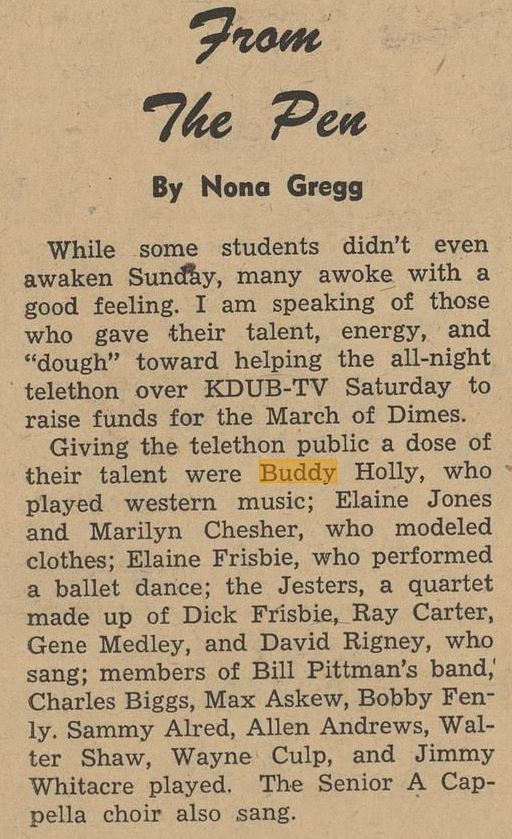 telethon on KDUB-TV, Holly seemed to take every opportunity he could to showcase his talents. It comes as no surprise that he would win the contest for “western instrument” in the school’s 1954 Round-Up show. Even back then, others could recognize Holly’s skill with a guitar.
telethon on KDUB-TV, Holly seemed to take every opportunity he could to showcase his talents. It comes as no surprise that he would win the contest for “western instrument” in the school’s 1954 Round-Up show. Even back then, others could recognize Holly’s skill with a guitar.
 Apparently music wasn’t the only thing that occupied Holley’s time in high school. Many issues from the Western World talk about his work as vice-president of the Vocational Industrial Club of Industrial Co-operative Training, and although I can only guess as to what he did in the club, I’d be willing to bet that just as with his music, Holley excelled there as well. For proof, you’d need look no further than the issue from March 26, 1954, which lists Holley as the first place winner in the competition for parliamentary procedure and drafting at the club’s district meet in Levelland, Texas. According to one issue, Buddy got to go to Austin to the state meeting of the Vocational Industrial Club of Texas.
Today, generations of music fans love and admire Buddy Holley, but back in high school, there was one person in particular who had special feelings for him–his high school sweetheart, Echo McGuire. One issue from 1953 lists Buddy and Echo in a segment simply titled, “Daters.”
Apparently music wasn’t the only thing that occupied Holley’s time in high school. Many issues from the Western World talk about his work as vice-president of the Vocational Industrial Club of Industrial Co-operative Training, and although I can only guess as to what he did in the club, I’d be willing to bet that just as with his music, Holley excelled there as well. For proof, you’d need look no further than the issue from March 26, 1954, which lists Holley as the first place winner in the competition for parliamentary procedure and drafting at the club’s district meet in Levelland, Texas. According to one issue, Buddy got to go to Austin to the state meeting of the Vocational Industrial Club of Texas.
Today, generations of music fans love and admire Buddy Holley, but back in high school, there was one person in particular who had special feelings for him–his high school sweetheart, Echo McGuire. One issue from 1953 lists Buddy and Echo in a segment simply titled, “Daters.”
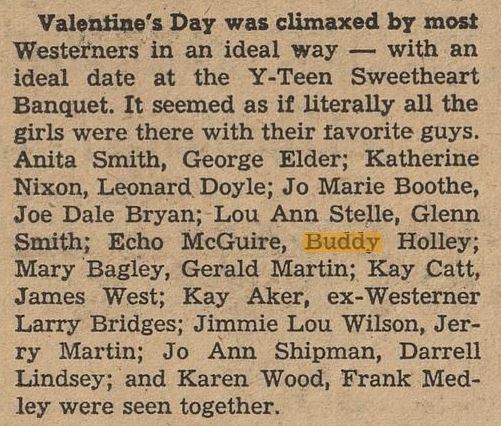 In fact, it seems the two were together throughout almost all of their time in high school. One issue from 1955 tells about how the two went to Nona Gregg’s 18th birthday party at the K.N. Clapp Party House in Lubbock. Another reports on their attending of the Y-Teen Sweetheart Banquet together on Valentine’s Day. Events like these, no matter how small and insignificant, paint an important picture of Holley’s youth, and although he’s no longer with us to share in these memories, we love having the chance to read about such moments. From the concerts in front of sold-out crowds to the good times with a few friends, all of these moments made up the Buddy Holly we know now and just as important, the Buddy Holley that came before.
I can’t remember if I cried
When I read about his widowed bride
But something touched me deep inside
The day the music died
In fact, it seems the two were together throughout almost all of their time in high school. One issue from 1955 tells about how the two went to Nona Gregg’s 18th birthday party at the K.N. Clapp Party House in Lubbock. Another reports on their attending of the Y-Teen Sweetheart Banquet together on Valentine’s Day. Events like these, no matter how small and insignificant, paint an important picture of Holley’s youth, and although he’s no longer with us to share in these memories, we love having the chance to read about such moments. From the concerts in front of sold-out crowds to the good times with a few friends, all of these moments made up the Buddy Holly we know now and just as important, the Buddy Holley that came before.
I can’t remember if I cried
When I read about his widowed bride
But something touched me deep inside
The day the music died

Texas State Historical Association. The Texas Historian, Volume 49, Number 1, September 1988. Austin, Texas. The Portal to Texas History. Accessed April 1, 2016.
 According to the review, “‘Star Wars’ features the most cosmic special effects in memory.” Unrelated but also interesting: on the same page of the review is a photo, “Dueling Banjo?” which displays a young David Iles with a terrific ’70s hairdo, wielding what appears to be a shovel-shaped sword. (David Iles also happens to be the sculptor of the wildlife statues outside the Environmental Education, Science, and Technology Building on the UNT Denton Campus.)
Of course, “Star Wars” came out before most of its top-billed cast were famous–except for Alec Guinness and Peter Cushing, and newspapers made certain to help movie-goers answer questions like, who was that tough guy from American Graffiti?
The Rice Thresher, out of Rice University, gives us an admiring and thoughtful review that especially praises the richness of the special effects. This review also notes newcomers Mark Hamill, Carrie Fisher, and Harrison Ford.
As we move toward the end of the year in our time machine, it appears that “Star Wars” gifts were at the top of most children’s wish lists by the end of 1977, from Bellaire, to Cedar Hill, to Crosbyton.
Not everyone was sad to change out movies at the theater. According to the September 16, 1977, NT Daily article, the Campus Theater projectionists were happy to see something new arrive after playing “Star Wars” for a total of 10 weeks–and after watching it over and over again. And if you’re curious about “so-called science fiction fizzlers” that “raked a coat-tail profit in the wake of ‘Star Wars,'” you need look no further than the November 17, 1977, issue of the Fort Hood Sentinel. From this, you’ll get reviews of such stunning classics as “Starship Invasions” and “The Fantastic Invasion of the Planet Earth.” (Before adding this paragraph, I checked the “Mystery Science Theater 3000” episode list to make sure neither of these movies had become an MST3k episode.)
According to the review, “‘Star Wars’ features the most cosmic special effects in memory.” Unrelated but also interesting: on the same page of the review is a photo, “Dueling Banjo?” which displays a young David Iles with a terrific ’70s hairdo, wielding what appears to be a shovel-shaped sword. (David Iles also happens to be the sculptor of the wildlife statues outside the Environmental Education, Science, and Technology Building on the UNT Denton Campus.)
Of course, “Star Wars” came out before most of its top-billed cast were famous–except for Alec Guinness and Peter Cushing, and newspapers made certain to help movie-goers answer questions like, who was that tough guy from American Graffiti?
The Rice Thresher, out of Rice University, gives us an admiring and thoughtful review that especially praises the richness of the special effects. This review also notes newcomers Mark Hamill, Carrie Fisher, and Harrison Ford.
As we move toward the end of the year in our time machine, it appears that “Star Wars” gifts were at the top of most children’s wish lists by the end of 1977, from Bellaire, to Cedar Hill, to Crosbyton.
Not everyone was sad to change out movies at the theater. According to the September 16, 1977, NT Daily article, the Campus Theater projectionists were happy to see something new arrive after playing “Star Wars” for a total of 10 weeks–and after watching it over and over again. And if you’re curious about “so-called science fiction fizzlers” that “raked a coat-tail profit in the wake of ‘Star Wars,'” you need look no further than the November 17, 1977, issue of the Fort Hood Sentinel. From this, you’ll get reviews of such stunning classics as “Starship Invasions” and “The Fantastic Invasion of the Planet Earth.” (Before adding this paragraph, I checked the “Mystery Science Theater 3000” episode list to make sure neither of these movies had become an MST3k episode.)
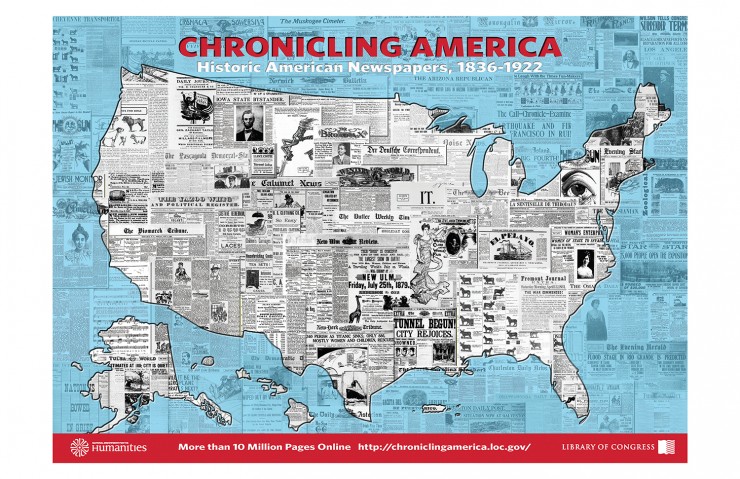 On October 7th, Chronicling America, the website through which the National Digital Newspaper Program (NDNP) content is hosted, reached a huge milestone in its history. “The site now features more than 10 million pages – 74 terabytes of total data – from more than 1,900 newspapers in 38 states and territories and the District of Columbia,” according to the 10-millionth page press release. Through the generous support of the National Endowment for the Humanities, which is celebrating its 50 year anniversary as an independent federal agency, Chronicling America serves as a free and open hub for newspaper preservation for participating institutions.
The University of North Texas Libraries, in partnership with the Dolph Briscoe Center for American History, has added 300,000 pages of Texas newspaper content to Chronicling America, and UNT Libraries and the Texas Digital Newspaper Program are proud to have participated. UNT Libraries also previously partnered with the Oklahoma Historical Society to complete 300,000 pages of Oklahoma newspapers for Chronicling America, and is currently partnering with University of New Mexico Libraries to add 300,000 pages of New Mexico newspapers.
Launched by the Library of Congress and the National Endowment for the Humanities in 2007, Chronicling America provides enhanced and permanent access to historically significant newspapers published in the United States between 1836 and 1922. It is part of the NDNP, a joint effort between the two agencies and partners in 40 states and territories.
The NDNP awards grants to entities in each state and territory to identify and digitize historic newspaper content. Awardees receive NEH funding to select and digitize 100,000 pages of historic newspapers published in their states between 1836 and 1922. Uniform technical specifications are provided to ensure consistency of all content, and digital files are transferred to the Library of Congress for long-term management and access. The first awards were made in 2005. Since then, NEH has awarded more than $30 million in support of the project.
If you’re interested in learning more about the National Endowment for the Humanities, NDNP, or the Library of Congress, visit their social media pages:
On October 7th, Chronicling America, the website through which the National Digital Newspaper Program (NDNP) content is hosted, reached a huge milestone in its history. “The site now features more than 10 million pages – 74 terabytes of total data – from more than 1,900 newspapers in 38 states and territories and the District of Columbia,” according to the 10-millionth page press release. Through the generous support of the National Endowment for the Humanities, which is celebrating its 50 year anniversary as an independent federal agency, Chronicling America serves as a free and open hub for newspaper preservation for participating institutions.
The University of North Texas Libraries, in partnership with the Dolph Briscoe Center for American History, has added 300,000 pages of Texas newspaper content to Chronicling America, and UNT Libraries and the Texas Digital Newspaper Program are proud to have participated. UNT Libraries also previously partnered with the Oklahoma Historical Society to complete 300,000 pages of Oklahoma newspapers for Chronicling America, and is currently partnering with University of New Mexico Libraries to add 300,000 pages of New Mexico newspapers.
Launched by the Library of Congress and the National Endowment for the Humanities in 2007, Chronicling America provides enhanced and permanent access to historically significant newspapers published in the United States between 1836 and 1922. It is part of the NDNP, a joint effort between the two agencies and partners in 40 states and territories.
The NDNP awards grants to entities in each state and territory to identify and digitize historic newspaper content. Awardees receive NEH funding to select and digitize 100,000 pages of historic newspapers published in their states between 1836 and 1922. Uniform technical specifications are provided to ensure consistency of all content, and digital files are transferred to the Library of Congress for long-term management and access. The first awards were made in 2005. Since then, NEH has awarded more than $30 million in support of the project.
If you’re interested in learning more about the National Endowment for the Humanities, NDNP, or the Library of Congress, visit their social media pages:
- LC Social Media
- Twitter: @librarycongress
- Facebook: https://www.facebook.com/libraryofcongress
- Pinterest: https://www.pinterest.com/LibraryCongress/
- NEH Social Media
- Twitter: @NEHgov
- Facebook: https://www.facebook.com/National-Endowment-for-the-Humanities-131252093552454/
- What People Are Saying About Chronicling America
- Silsbee Public Library: Received a Tocker Foundation grant to digitize its Silsbee Bee.
- Wharton County Library: Received a Tocker Foundation grant to digitize Wharton County area newspapers, representing the communities of El Campo and Wharton.
- Nellie Pederson Library: Received a Tocker Foundation grant to digitize the Clifton Record and Clifton Enterprise, in collaboration with the Cleng Peerson Research Genealogy Library.
- Jackson County Memorial Library: Received a Tocker Foundation grant to digitize Edna and Jackson County area newspapers.
- Ennis Public Library: Received a Hancher Foundation grant to digitize the Ennis area newspapers, including the Ennis News.
- Burleson Public Library: Received a Hancher Foundation grant to digitize south Tarrant County area newspapers, representing the communities of Burleson, Alvarado, Keene, and Everman.
- Taylor Public Library: Received a Hancher Foundation grant to digitize selected years of its community and county newspapers.
- The Tarrant County Archives: Received a Rescuing Texas History 2015 Newspaper grant to digitize selected newspapers from the early years of Tarrant County.
- Texas Lutheran University: Received a Rescuing Texas History 2015 Newspaper grant to digitize selected years of its student newspaper, Lone Star Lutheran.
- Crockett County Public Library: Received a Rescuing Texas History 2015 Newspaper grant to digitize selected years of its area newspaper collection.
- San Jacinto Community College-South Campus Library: Received a Rescuing Texas History 2015 Newspaper grant to digitize selected years of the South Belt/Ellington Leader newspapers.
- The Humble Museum: Received a Rescuing Texas History 2015 Newspaper grant to digitize selected years of the Humble Echo.
- St. Mary’s University Library: Received a Rescuing Texas History 2015 Newspaper grant to digitize selected years of its student newspaper, The Rattler.
- Mesquite Public Library: Received a Rescuing Texas History 2015 Newspaper grant to digitize selected years of the Texas Mesquiter.
- Texas State University: Received a Rescuing Texas History 2015 Newspaper grant to digitize selected years of its student newspaper, The College Star.
- Friench Simpson Memorial Library: Received a Rescuing Texas History 2015 Newspaper grant to digitize selected years of The Hallettsville Herald and The New Era.
- Lamar University Mary & John Gray Library: Received a Rescuing Texas History 2015 Newspaper grant to digitize The Pine Needle.
- McKinney Public Library: Received a Rescuing Texas History 2015 Newspaper grant to digitize selected years of the McKinney Courier-Gazette.
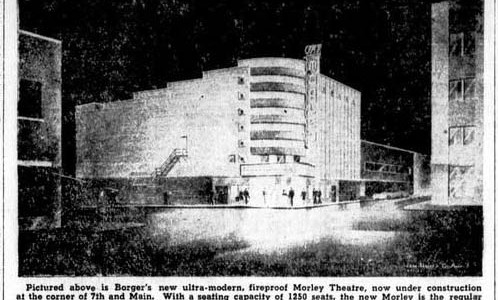
Part II, continued from May’s “Shopping for Houses in Newspapers”
We look at lots of newspaper pages here at the Texas Digital Newspaper Program. Lots. In the course of our work, we can’t help ourselves from stopping to read some of the articles or to admire the old advertisements and graphics. Often, when reading a story about a particular person or event, I’m driven to investigate further to find out how the story ends. And as someone with an affinity for old buildings (see previous post), I’m often finding myself doing some “Google Tripping” to find out the fate of these buildings I see in the newspapers. Google Tripping for me is simply the act of looking up a location on Google Maps Street View to see what it looks like today. Newspapers of the past are filled with announcements of new constructions, advertisements for real estate, event listings, etc., that offer a glimpse into the history of our built environment. As you will see in this post, there are some happy endings, some hopeful stories, and inevitably some losses. First up, we take a trip to El Paso. While working on the metadata for our El Paso Times and El Paso Herald newspaper collections, I quickly realized that there was a goldmine of real estate advertisements in these papers, many of which included photographs and detailed information. I got caught up in one issue in particular, from August 25, 1917, of the El Paso Herald. In fact, I was so enmeshed, I had to stop myself from making this entire post about the buildings found in this issue. From El Paso, I was finally able to select two buildings for this post. The amount of attention devoted to these homes shows that they were clearly significant structures at the time. First up is a home that is still going strong with beautiful landscaping and even some classy topiary, seen below.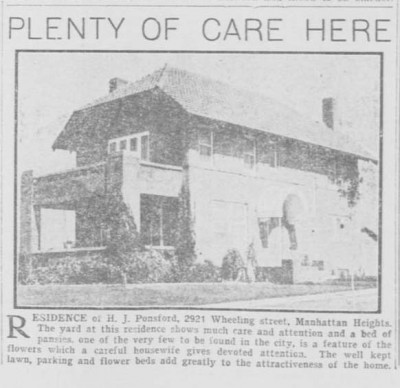 |
 |
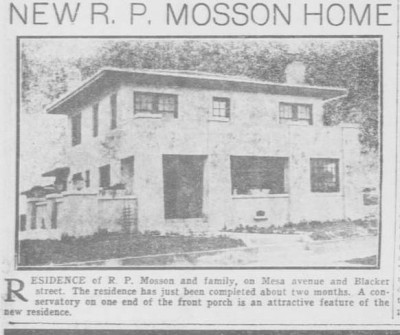 Now for something that has changed roles a bit, we look at the former R. P. Mosson home located at Mesa Avenue and Blacker Street. At first glance, a passerby may not associate the former single-family home on the left with the business location below, but a closer look reveals that the roof-line matches and that it even retains its two original chimneys.
Now for something that has changed roles a bit, we look at the former R. P. Mosson home located at Mesa Avenue and Blacker Street. At first glance, a passerby may not associate the former single-family home on the left with the business location below, but a closer look reveals that the roof-line matches and that it even retains its two original chimneys.
 The side porch and the front porch with a conservatory have been altered, but their outline is still recognizable. I’ve quickly learned that a paper with extensive real estate advertising makes it easy to get carried away Google Tripping. But sometimes you come across things serendipitously that need to be looked into.
While looking for a different building (that no longer exists) while Google Tripping in Borger, Texas I stumbled on a huge theater that piqued my interest. A quick search through the Borger Daily Herald resulted in this advertisement for a new
The side porch and the front porch with a conservatory have been altered, but their outline is still recognizable. I’ve quickly learned that a paper with extensive real estate advertising makes it easy to get carried away Google Tripping. But sometimes you come across things serendipitously that need to be looked into.
While looking for a different building (that no longer exists) while Google Tripping in Borger, Texas I stumbled on a huge theater that piqued my interest. A quick search through the Borger Daily Herald resulted in this advertisement for a new  fireproof theater opening in Borger. Amazingly, The Morley Theatre (seen left) is still showing movies today! I wonder if they still have the “ladies’ cry room” or “smoker?” While these articles made the Google Tripping easy by providing addresses or cross streets, occasionally some digging is required to find the current location.
fireproof theater opening in Borger. Amazingly, The Morley Theatre (seen left) is still showing movies today! I wonder if they still have the “ladies’ cry room” or “smoker?” While these articles made the Google Tripping easy by providing addresses or cross streets, occasionally some digging is required to find the current location.  Recently, I also learned about The Praetorian Building, the first skyscraper, not just in Dallas, but in the entire Southwestern United States. There are many mentions of this famous building on The Portal to Texas History, including these advertisements. Reading about the history of the building was rather sad and too complicated to dive into here. Unfortunately, the building was razed a few years ago, which is too often the outcome for many buildings I search for, but what replaced The Praetorian Building surprised me, and I’d like to think that the ghost of The Praetorian Building is still keeping an eye on things in Dallas. I would love to keep Google Tripping today, but more newspaper metadata awaits. Now it’s your turn. Armed with the information provided by the Texas Digital Newspaper Program you can now take your own Google Trip!
Recently, I also learned about The Praetorian Building, the first skyscraper, not just in Dallas, but in the entire Southwestern United States. There are many mentions of this famous building on The Portal to Texas History, including these advertisements. Reading about the history of the building was rather sad and too complicated to dive into here. Unfortunately, the building was razed a few years ago, which is too often the outcome for many buildings I search for, but what replaced The Praetorian Building surprised me, and I’d like to think that the ghost of The Praetorian Building is still keeping an eye on things in Dallas. I would love to keep Google Tripping today, but more newspaper metadata awaits. Now it’s your turn. Armed with the information provided by the Texas Digital Newspaper Program you can now take your own Google Trip!  This week, we have an invited guest blogger, Tim Gieringer. Here on the Digital Newspaper Team, Tim creates all the metadata for the newspapers we upload. He’s been doing a lot of research for this guest post, so I hope you enjoy!
Thank you for inviting me to do this post! I’ve always had an interest in history, research, and architecture. Since moving to Denton, I have been involved in providing research for historical markers for the county’s Historic Iron Bridges project and researching dozens of homes for City of Denton Historic Landmark designation applications (including my own). This research often involves using historic newspapers on The Portal to Texas History.
Some of the more fascinating and popular items found in historic newspaper collections are the advertisements. Whether for unfamiliar products of the past or for early versions of products that remain household names today, the ads seem to still catch your eye. Of course, that’s what they were designed to do. I have long had an interest in historic homes, so my eyes are naturally drawn to advertisements for houses. When looking through these old house advertisements, some of you may be surprised to learn that buying a house in the early part of the 20th-century often meant first picking up a newspaper. From there, you may have been swayed to send off for a mail-order house catalog or visit a local business to see their house plan catalogs and displays. Indeed, unless you were wealthy enough to hire an architect to design your home, chances are you were building your new home entirely through mail-order or hiring someone to build it based off a set of plans you had purchased.
This week, we have an invited guest blogger, Tim Gieringer. Here on the Digital Newspaper Team, Tim creates all the metadata for the newspapers we upload. He’s been doing a lot of research for this guest post, so I hope you enjoy!
Thank you for inviting me to do this post! I’ve always had an interest in history, research, and architecture. Since moving to Denton, I have been involved in providing research for historical markers for the county’s Historic Iron Bridges project and researching dozens of homes for City of Denton Historic Landmark designation applications (including my own). This research often involves using historic newspapers on The Portal to Texas History.
Some of the more fascinating and popular items found in historic newspaper collections are the advertisements. Whether for unfamiliar products of the past or for early versions of products that remain household names today, the ads seem to still catch your eye. Of course, that’s what they were designed to do. I have long had an interest in historic homes, so my eyes are naturally drawn to advertisements for houses. When looking through these old house advertisements, some of you may be surprised to learn that buying a house in the early part of the 20th-century often meant first picking up a newspaper. From there, you may have been swayed to send off for a mail-order house catalog or visit a local business to see their house plan catalogs and displays. Indeed, unless you were wealthy enough to hire an architect to design your home, chances are you were building your new home entirely through mail-order or hiring someone to build it based off a set of plans you had purchased.
Mail-Order Homes
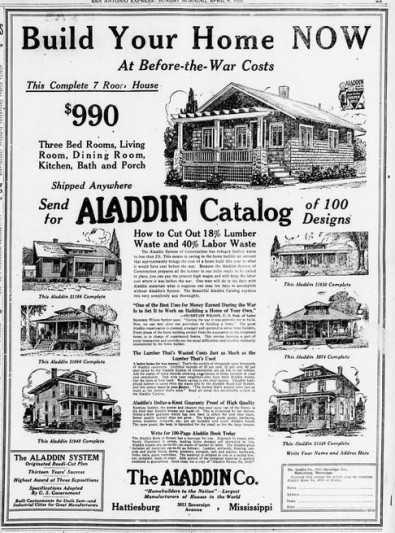 |
At one point in time, you could pick a house out of a catalog and literally have it shipped in its entirety to you with instructions on how to build it. By “entirety,” I mean from the wood, right down to the sinks and door hinges on the inside. The houses usually came by railroad and could be constructed by a contractor or sometimes even by a handy homeowner. Sears is by far the most famous company to widely offer these mail-order homes. (It’s a fun trivia fact that people like to throw around, and there are a lot of people devoted to identifying Sears homes.) However, Sears had several competitors, one of the largest being a Michigan-based company called Aladdin. As you can see from this 1919 San Antonio Express Aladdin ad, two of their main selling points were the many designs available and monetary savings from cutting lumber and labor cost, with the idea being that the lumber came to you already cut to specifications and thus requiring less time to prepare. |
Plan Book Homes
| Another popular method for new home owners was picking out a house plan from a catalog and hiring a local company or contractor to build your home based on those plans. These plans could be ordered through the mail, or you could visit a local company, usually a lumber company, that would also sell you the materials and help you consult their catalogs and displays. | 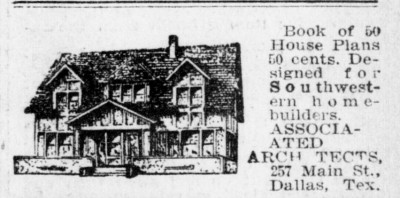 |
 As I was putting images together for this article, I was surprised to find that there may have been some contempt between the mail-order and plan book home companies. The 1919 ad from the Burleson County Ledger, the title image for this post, states, “Our lumber worked by Ye Planry plans will build a home with an air of individuality and not have that ready-cut look.” I am still watching my mailbox for a reply from the mail-order companies.
This is just a quick look at a couple ways many of the older homes in our communities may have been built. I hope this encourages you to look closer next time you see an old home and try to figure out if it was mail-order, plan book based, or custom built. The fascinating thing about old homes is they all have a story to tell. There’s a chance that you might walk past a Ye Planry Home every day without even knowing it! For the next time Ana asks me to be a guest blogger, we’ll take some Google Map trips and tour the past as it exists in the present!
As I was putting images together for this article, I was surprised to find that there may have been some contempt between the mail-order and plan book home companies. The 1919 ad from the Burleson County Ledger, the title image for this post, states, “Our lumber worked by Ye Planry plans will build a home with an air of individuality and not have that ready-cut look.” I am still watching my mailbox for a reply from the mail-order companies.
This is just a quick look at a couple ways many of the older homes in our communities may have been built. I hope this encourages you to look closer next time you see an old home and try to figure out if it was mail-order, plan book based, or custom built. The fascinating thing about old homes is they all have a story to tell. There’s a chance that you might walk past a Ye Planry Home every day without even knowing it! For the next time Ana asks me to be a guest blogger, we’ll take some Google Map trips and tour the past as it exists in the present!
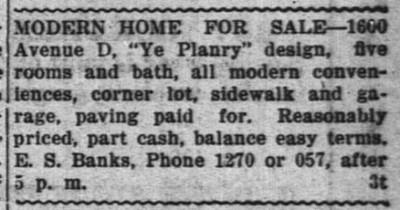 |
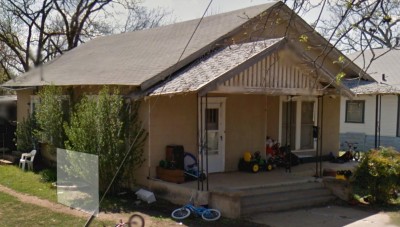 |



